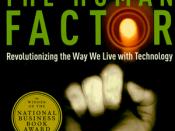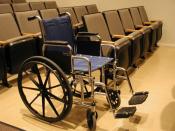Human Factor engineering is the field of engineering involving research into human psychological, social, physical, and biological characteristics, maintaining the information obtained from that research, and working to apply that information with respect to the design, operation or use of products or systems for optimizing human performance, health, safety, and or habitability. The main idea behind Human Factors engineering is to know your user and design a product that appeals him based on his preferences and characteristics. The concept of Human Factors emerged during the World War II when fighter pilots shot their own planes. This was mainly due to the machinery that they used was very complex by human standards and was very difficult to control. It was apparent at that time that such a disaster occurred because the Human Factors of the fighter pilots were not understood properly. Soon a solution was found and the system changed, people with a certain amount of experience were selected for the job, they were trained more often and smarter guns were built that were easier to operate.
Attempt was made to fit the job to the fighter pilots rather than trying to fit the fighter pilots to the job.
Is Human Factors engineering just plain and simple common sense? Well, no, not at all. If Human Factors was such an easy concept to grasp then why are they so commonly violated? and disasters due to human error continue to occur. Human errors can be of many forms which could range from wrong attitude to perception misjudgment to an improper operation of equipment. According to a report published by NTSB (National Transportation Safety Board) it was cited that 80 percent of the air crashes are due to human error. A chart below that was published by the NTSB (National Transportation Safety Board) further breaks down human error into categories and strengthens my point that Human Factors engineering is not just plain and simple common sense.
A model that is constructed based on Human Factors engineering is called a balanced model. An individual might have many needs and preferences based on his perception, habits, needs, intelligence, biological characteristics etc., but designing a model that serves all of his needs and preferences is not possible. So we design a model that is of a proper "fit", a model that will serve most of his needs and preferences to the maximum. Such a model is called a Balanced Model. For example, a disabled person on a wheel chair might want his wheel chair to have a very comfortable seating arrangement with a lot of padding and cushioning and will also want the wheels on his wheel chair to be very easy to push with his hands so that he can move in around with the minimum possible effort. If the cushioning on the wheel chair is increased then the wheel chair will become heavy making it increasingly difficult to move around and if the cushioning is removed then the wheel chair will be very uncomfortable for the user. Therefore a model of proper "fit" or a balanced model needs to be developed which is neither too heavy for the user nor is it very uncomfortable for him.
Individual differences are also a very critical component of Human Factor engineering. Everyone individual is different and has different needs, but customizing is impossible for each individual due price constraints. Therefore it is critical that we understand the individuals and the group and develop a model that will not only appeal to the individual; but also to the group. Such an approach will not only make the product more affordable but also appealing to a larger number of individuals.
How are systems to be designed? Our goal here is to design a model with a range of characteristics rather than the average and Human Factor engineering helps us do exactly that. Human Factors engineering based on individual differences can be seen in almost every product. It can range from our car to our computer to our gym gloves that we use everyday without thinking of the amount of research that must have gone into making that product. A car has adjustable seating in it so that it can be operated by a person who is shorter than 5 feet or for a person who is taller than 7 feet. Even the seatbelts have multiple adjustable positions on them so that they could be used by almost everyone, from infants to adults. Our computers have keyboards with keys with the right amount of spacing so that a person with thin fingers or a person with fat fingers can operate without much difficulty. Even the monitors that we have are adjustable one can move them up, down, left and right without any difficulty. Even the gym gloves that I use have Velcro in them and are made of a material called lycra which is stretchable so that a person with short fingers or fat fingers or a person with long fingers can wear them. How often have we seen a sign that says one size fits all? when we go to buy a cap or some other apparel. How is this made possible? The correct answer is Human Factor engineering based on individual differences.
An individual's response to his environment is also a very essential part of Human Factor engineering. Ones response to his environment is based on how one perceives his environment; an individual perceives his environment mainly through the sense on touch, audition and vision. More 80 percent of the information that an individual gets is through his eyes or vision and the rest from the sense of touch and audition.
In lecture we discussed many parts of the eye like the cornea, lens and the pupil. A lot of time was also spent on the lens and its components. Retina contains visual receptors cones and rods. Cones are used for color vision and are much frequent in number than the rods which are used to detect black and grey. It was also learned that the eye takes nearly 30 minutes to adapt from light to dark while it just takes a few seconds to adapt to light. This clearly shows us that the light the eye is slow when it comes to dark adaptation. Even some basic concepts like nearsightedness, farsightedness, astigmatism, forea and contrast were discussed briefly in the class. The understandings of these concepts are very essential when designing an effective model. For example, our computer monitors need to have the right amount of light, and contrast for us to be able to see what is on the screen clearly. Even the prescribed glasses have to be developed taking these concepts into account.
More than 80 percent of the information that an individual gets is through his eyes or vision. This is a critical information that one has to take into consideration while designing an effective model. Fire alarms have very bright, shiny lights accompanied by loud noise in order to attract attention. Even lighthouses have light signals to warn ships, and even the traffic on roads is controlled through light signals with different lights signaling different actions.
While vision is a chemical process, hearing is a mechanical process which then converts into an electrical process. The outer ear collects sound energy and vibrates the ear drum. These vibrations are transmitted to the oval window and stimulate the organ of the corti, which converts the vibrations into electrical signals that move up auditory nerve of the brain. Unlike the vision one can respond to sound even if one is not directly focused on it. We respond differently to different levels of sound. If we hear loud noises then we are most likely to respond to it more quickly than to a quiet noise. This is why in fire alarms we have bright lights along with loud noises. The loud noise ensures that we respond to the fire alarm even if we cannot see the bright lights and that we respond to the fire alarm quickly.
The sense of stimuli is also a very important aspect that one needs to consider that while developing an effective model. Our response to the sense of stimuli is the fastest. So in situations where we need a quick response from an individual we should use the sense of stimuli. While the sense of stimuli is still not a very commonly used but I am sure in the future it will be used to build more effective models.


